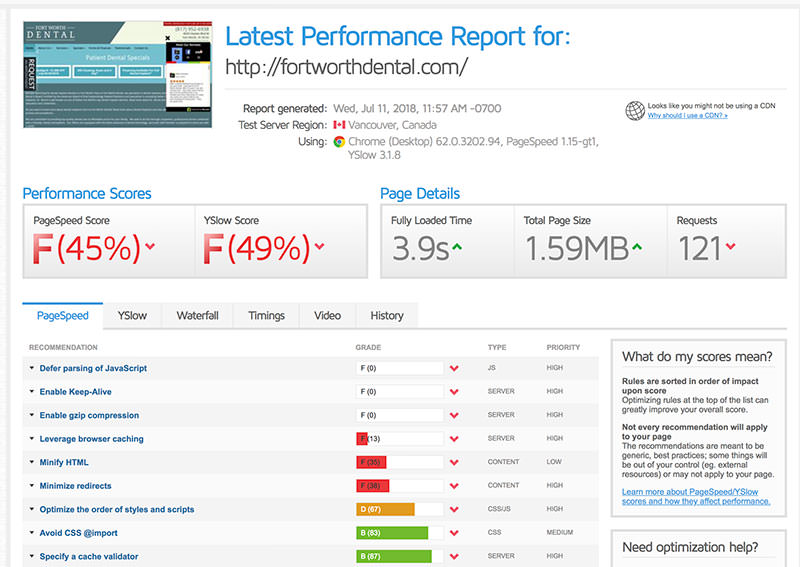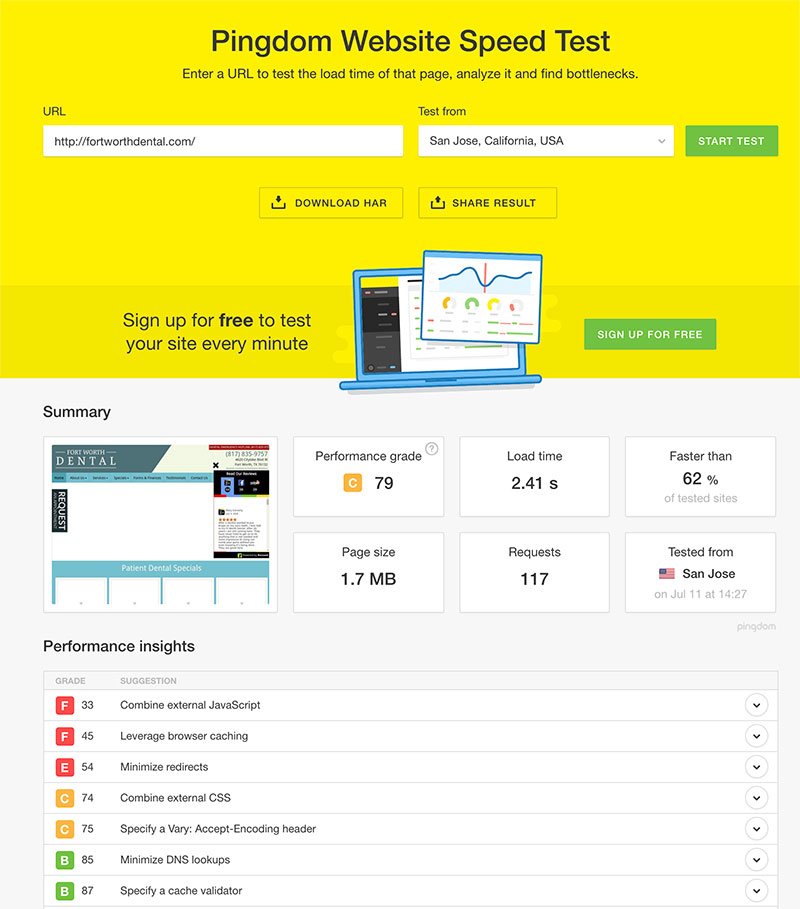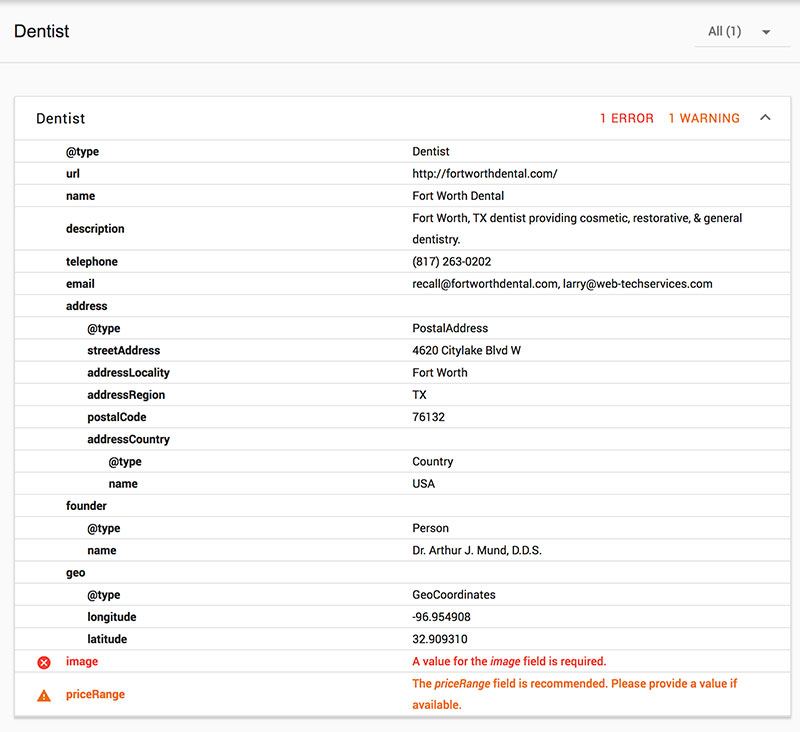In this post, we are going to look at the top ranking websites in local Dentist niche. To understand why these websites are ranking and sitting at the top of the Google results, we will analyze their websites and look at their off-site SEO strategies.
If you are a local Dentist looking to obtain more customers, it is important to be at the top of Google for search terms that relate to your services. Potential new clients use Google every day searching for a local Dentist.
As mentioned in the Referring Domains & Backlink video below, the search phrase “dentist fort worth” get around 3,000 searches per month. Those are all potential new customers for the Dentist at the top of the search results.
Dentist SEO in Fort Worth
As I have mentioned in several of my posts and videos, I am located in Fort Worth, Texas. Because of this, I have decided to analyze the SERPs around my location. The same tactics, strategies, and analysis can be used for any location.
If you are new to search engine optimization, I would recommend reading some of my other posts and guides to get up to speed. Start with How Do I Get My Website to the Top of Google?, then move on to my Local On-Site SEO Guide, and then finally the Local Off-Site SEO Guide.
Once you read and understand what SEO is and why it is important to your business, use the following information and videos as a guideline and blueprint for your SEO efforts.
Dentist On-Site SEO
On-site or on-page SEO is always the best place to start an SEO campaign. If I am working with a new client, an on-site audit is the first thing I do. Just implementing on-site best practices on an existing website can make a website jump up in the search engine rankings alone.
Following my Local On-Site SEO Guide will get you started off on the right foot, but I also like to look at the current top ranking websites in my niche and analyze/audit the websites. Not only does this uncover what is working in the current rankings, but it also gives me areas where I can improve for the website I am trying to rank.
To start this process, I normally run my top three to five organic search competitors through a few tools.
GTMetrix
GTMetrix is a tool that will analyze a site’s speed. Google and other search engines are all about FAST websites. I like to run my competitors websites in this tool to see if their website is optimized to load as fast as possible. When it comes to my competitor’s sites, the slower, the better.
Why?
Because the site I am working on will be as fast as possible!
Let’s looks at one of the top websites for the search phrase “dentist fort worth” in my location.
PageSpeed Score: F
YSlow Score: F
Fully Loaded Time: 3.9 seconds
As you can see, this is not very good. There are all kinds of case studies that discuss how a website conversion rate correlates with page load times.
In short, the faster, the better.
If I am a local dentist in Fort Worth and I see this, I get excited because there is a lot of room for improvement.
PageSpeed Insights
Google also provides a speed test tool called PageSpeed Insights. It doesn’t give as much detail as GTMetrix, but it is nice to see what Google thinks about a website.
Looking at Fort Worth Dental website in this tool, we get the following report:
This report is on a scale of 0-100, with the latter being the best score you can get within the PageSpeed Insights tool. As you can see, there is some work that can be done to improve this website.
Again, a lot of opportunity for any other local Fort Worth Dentist.
I do want to note that I do not stress out about getting a perfect 100 score. As long as I get a green status in the 90s, I move on and skip any suggestions that are irrelevant. For example, the suggestion to leverage browser caching for Google Analytics.
At the end of the day, your primary focus shouldn’t be about your PageSpeed Insight grade. It should be about your website speed which brings us to the next tool.
Pingdom
Pingdom is a tool similar to GtMetrix that analyzes your website speed. Again, your focus should be on your website speed and load time.
The faster, the better.
Similar to the report above, you can see the Pingdom results for the Fort Worth Dental website below:
Use these speed insights and reports to your advantage.
Run the website you are working on through these tools and get your websites running and loading as fast as possible.
Schema Testing Tool
Google provides a Structured Data Testing Tool to validate the schema markup on a website. Not only is this good for validating your schema markup, but you can also spy on your competitors and see how they are using schema markup.
You can see the schema data report for the Fort Worth Dental website below:
Notice the website is using the Dentist schema type which is good, but they also have an error. Not only do they have an error for not including an image, but if you look at the Dentist schema documentation, you will notice they could have used more schema properties.
As I mention in the Local On-Site SEO Guide, schema helps Google and other search engines determine what your content is about on your website. Like with anything else on the web, the more information you can provide the better.
My recommendation here would be to review the Dentist schema type documentation and add as many properties as possible. Depending on the niche, you can also use schema throughout your website to markup different types of data.
After adding schema to your web pages make sure you do not have any errors in the Structured Data Testing Tool.
Screaming Frog
Once I figure out if there are any opportunities from competitors page speed and schema, I start looking at the other on-site SEO factors.
These include things like:
- Secure pages with an SSL certificate
- Responsive web design
- Content
- URL structure
- Meta tags
- Internal linking
Other than manually auditing a website the Screaming Frog tool helps with the on-site SEO process. Downloading the tool and inserting a website will analyze and return useful data.
Screaming Frog crawls and returns all the pages of a website, the meta tags, header content, word content, and much more.
When doing competitive analysis, I use this tool to quickly and efficiently compare and find insights about my competitor’s websites.
For example, I can quickly see the word content of each page. With this information, I can create better content because as we know, content is king. I also look at the meta tags, h1, h2, and URLs to see if and how often keywords are used.
This gives me a baseline and also some insight on what Google is looking for in this specific niche.
Building and Implementing an Optimized Website
I usually do the above on-site SEO audits for the top three to five competitors in the niche I am working on. Every niche is different, but you will find a lot of similarities.
Once I understand what Google is looking for in the local niche and how my competitor’s websites are optimized for search engines, I take all my findings and try to improve on each element.
There are SEO best practices that you always want to implement and optimize when building a local website.
Some examples include:
- SSL certificate
- Responsive design
- Internal linking
- Meta tags
- Robots.txt
- Sitemap
- Schema markup
- Unique content, imagery, multimedia
- Proper URLs
Based on the competitor audits, there are some quick wins.
For example, the Fort Worth Dental website we audited above doesn’t have an SSL certificate. They have very little content throughout the site. Very little internal linking and use of heading tags. Minimal images or multimedia throughout the site. Poorly optimized meta tags. Their website loads very slow.
These are all things that you can improve on when building and optimizing your website.
Dentist Off-Site SEO
A websites on-site SEO is just one piece of the SEO puzzle. The other piece is, of course, off-site SEO or off-page SEO.
If you need a little background information on this topic, please read the Local Off-Site SEO Guide before moving forward.
For this section, I put together some videos to help explain how to do backlink, anchor text, and keyword research for the Dental niche.
Backlinks & Referring Domains
The first video goes over backlinks and referring domains for the “dentist fort worth” search phrase.
After watching the video above, you should understand why backlinks are important for your SEO rankings. I also go over how to use ahrefs.com to analyze and see a websites backlinks and referring domains.
This is a very important insight to have about your competitors. You can use the referring domain report to find and build similar backlinks to your website.
The goal is to get high quality, relevant backlinks to your website.
Anchor Text Strategy
The following video looks at the anchor text strategy for the top ranking sites for the search phrase “dentist fort worth.”
Understanding the anchor text strategy for the top ranking websites in your niche is important. This helps you determine what Google is looking for when determining site placement within the SERPs.
Using this knowledge will help you determine what anchor text you should use when building backlinks to your website.
Keyword Research
Knowing what search terms people are searching for in your niche is important. The goal is to rank for keywords that relate to your services that drive customers to your business.
In the following video, I go over some tools that will help you find keywords that relate to your niche. I also show you how you can spy on your competitors and uncover keywords for your pages and potential blog posts.
Don’t just assume you know what keywords that will drive traffic and potential customers to your website. The goal is to create pages and blog posts around keywords and topics that have search volume.
Start Dominating the Local Dentist Niche
Hopefully, this information helped you understand how to analyze the local SERPS and the steps needed to rank a dentist website. If you have any questions or would like more details on a certain topic, please feel free to reach out.




